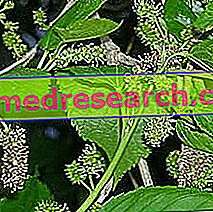
Scientific name
Morus nigra
Family
Rosaceae
Origin
China
Synonyms
Black mulberry
Used Parts
The drug consists of ripe berries, leaves and bark of the mulberry root.
Chemical constituents
The main chemical constituents of mulberry fruits are:
- Fruit acids (among which we find malic acid and citric acid);
- pectin;
- Sucrose;
- Flavonoids;
- Ascorbic acid.
Flavonoids are the main chemical constituents of the leaves.
Mulberry in Herbalist: Properties of the Mulberry
Mulberry infusions and extracts are used as hypoglycemic agents, although there are no certain clinical studies.
The bark of the dried root of the black mulberry, on the other hand, is considered purgative and tenifuga.
Biological activity
The use of mulberry has not obtained official approval for any type of therapeutic use, although several studies have been carried out to investigate its potential properties.
An interesting study conducted on animals has shown that the flavonoids and anthocyanins contained in mulberry fruits possess marked anti-inflammatory and analgesic activities. These properties seem to be explained by a mechanism of inhibition of the activity of different types of pro-inflammatory cytokines.
Another study conducted on animals, on the other hand, has highlighted the remarkable antioxidant properties of flavonoids contained in black mulberry. In fact, it seems that these molecules are able to decrease the blood and liver levels of malondialdehyde (a marker used to determine peroxidative damage) and that, at the same time, are able to increase the activity of enzymes such as superoxide dismutase, catalase and glutathione peroxidase (all fundamental enzymes in the detoxification processes of cells from free radicals).
Another research carried out on diabetic animals, on the other hand, has shown how the intake of mulberry leaf extracts can be useful in decreasing excessively high blood sugar levels and can promote an increase in blood insulin levels, in addition to performing a antioxidant type action.
However, despite the encouraging results obtained, before the use of mulberry can be approved for any of the aforementioned therapeutic applications, in-depth clinical studies are required.
Mulberry in folk medicine and homeopathy
In folk medicine, mulberry is used as a mild laxative and as a remedy for inflammation of the mucous membrane of the respiratory tract, but not only. In fact, mulberry is used in traditional medicine as a diuretic, astringent, antiseptic, expectorant, antipyretic and antihypertensive remedy.
Furthermore, mulberry is also used in homeopathic medicine, where it can easily be found in the form of mother tincture, oral drops and granules. In this field, the plant is used in cases of diabetes, diabetic vasculopathy, diabetic retinopathy, diabetic ulcers, dysphagia, hiatal hernia and chronic pancreatitis.
The dose of homeopathic remedy to be taken may differ from individual to individual, also depending on the disorder to be treated and the type of homeopathic preparation and dilution that is intended to be used.
Contraindications
Avoid taking in case of hypersensitivity to one or more components.
Pharmacological Interactions
- possible addition of effects with oral hypoglycemic agents.



